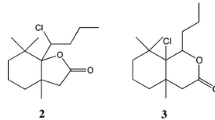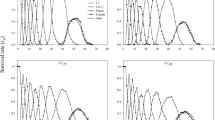Abstract
A total of 25 compounds including benzoxazinones, benzoxazolinones, and N-glyoxylamide derivatives were tested as antifeedants and antibiotics towards the aphid Sitobion avenae in diet bioassays. The antifeedant and mortality indexes increased with the presence of electron-donating groups in the 7 position of the benzoxazinone moiety, the replacement of the oxygen atom by sulfur in the heterocyclic ring, the presence of a hemiacetal instead of an acetal at C-2 of the benzoxazine moiety (and hence the possibility of ring opening), and the presence of a hydroxyl group at C-4 of the benzoxazine moiety (hydroxamic acid) instead of a hydrogen atom (lactam). The results support earlier hypotheses on the chemical bases for the mode of action of these compounds.
Similar content being viewed by others
REFERENCES
ArgandoÑa, V. H., Luza, J. G., Niemeyer, H. M., and Corcuera, L. J. 1980. Role of hydroxamic acids in the resistance of cereals to aphids. Phytochemistry 19:1665-1668.
ArgandoÑa, V. H., Niemeyer, H. M., and Corcuera, L. J. 1981. Effect of content and distribution of hydroxamic acids in wheat on infestation by the aphid Schizaphis graminum. Phytochemistry 20:673-676.
ArgandoÑa, V. H., Corcuera, L. J., Niemeyer, H. M., and Campbell, B. C. 1983. Toxicity and feeding deterrency of hydroxamic acid from Gramineae in synthetic diets against the greenbug, Schizaphis graminum. Entomol. Exp. Appl. 34:134-138.
Atkinson, J., Morand, P., Arnason, J. T., Niemeyer, H. M., and Bravo, H. R. 1991. Analogues of the cyclic hydroxamic acid 2,4-dihydroxy-7-methoxy-2H-1,4-benzoxazin-3(4H)-one: Decomposition to benzoxazolinones and reaction with β-mercaptoethanol. J. Org. Chem. 56:1788-1800.
Bohidar, K., Wratten, S. D., and Niemeyer, H. M. 1986. Effects of hydroxamic acids on the resistance of wheat to the aphid Sitobion avenae. Ann. Appl. Biol. 109:193-198.
Bravo, H. R., and Niemeyer, H. M. 1985. Decomposition in aprotic solvents of 2,4-dihydroxy-7-methoxy-1,4-benzoxazin-3-one, a hydroxamic acid from cereals. Tetrahedron 41:4983-4986.
Cuevas, L., and Niemeyer, H. M. 1993. Effect of hydroxamic acids from cereals on aphid cholinesterases. Phytochemistry 34:983-985.
Cuevas, L., Niemeyer, H. M., and PÉrez, F. J. 1990. Reaction of DIMBOA, a resistance factor from cereals, with α-chymotrypsin. Phytochemistry 29:1429-1432.
Givovich, A., and Niemeyer, H. M. 1991. Hydroxamic acids affecting barley yellow dwarf virus transmission by the aphid Rhopalosiphum padi. Entomol. Exp. Appl. 59:79-85.
Givovich, A., and Niemeyer, H. M. 1995. Comparison of the effect of hydroxamic acids from wheat on five species of cereal aphids. Entomol. Exp. Appl. 74:115-119.
Hartenstein, H., and Sicker, D. 1994. α-Hydroxylation of cyclic hydroxamic acids by peroxide oxidation: A novel approach to allelochemicals from Gramineae. Tetrahedron Lett. 35:4335-4338.
Hartenstein, H., Lippmann, T., and Sicker, D. 1992. An efficient procedure for the isolation of pure 2,4-dihydroxy-7-methoxy-2H-1,4-benzoxazin-3(4H)-one (DIMBOA) from maize. Indian J. Heterocycl. Chem. 2:75-76.
Hashimoto, Y., and Shudo, K. 1996. Chemistry of biologically active benzoxazinoids. Phytochemistry 43:551-559.
Hashimoto, Y., Ohta, T., Shudo, K., and Okamoto, T. 1979. Reactions of 4-acetoxy-2H-1,4-benzoxazin-3-ones with some nucleophiles. Tetrahedron Lett. 1979:1611-1614.
Hashimoto, Y., Ishizaki, T., and Shudo, K. 1991. A multi-centered electrophile formed from a unique bioactive cyclic hydroxamic acid, 4-hydroxy-7-methoxy-2H-1,4-benzoxazin-3(4H)-one. Tetrahedron 47:1837-1860.
Hofman, J., and Hofmanova, O. 1969. 1,4-Benzoxazin derivatives in plants. Sephadex fractionation and identification of a new glucoside. Eur. J. Biochem. 8:109-112.
Honkanen, E., and Virtanen, A. I. 1960. Synthesis of some 1,4-benzoxazine derivatives and their antimicrobial activity. Acta Chem. Scand. 14:1214-1217.
Ishizaki, T., Hashimoto, Y., and Shudo, K. 1992. Importance of the 2-hydroxy group for the reactions of an acetate of a naturally occurring prohibition, 4-acetoxy-2-hydroxy-2H-1,4-benzoxazin-3(4H)-one, with nucleophiles. Heterocycles 34:651-656.
Kluge, M., Hartenstein, H., Hantschmann, A., and Sicker, D. 1995. First syntheses of natural products with the 2,7-dihydroxy-2H-1,4-benzoxazin-3(4H)-one skeleton. J. Heterocycl. Chem. 32:395-402.
Long, B. J., Dunn, G. M., Bowman, J. S., and Routley, D. G. 1977. Relationship of hydroxamic acid content in corn and resistance to the corn leaf aphid. Crop Sci. 17:55-58.
Nicol, D. S., Copaja, S. V., Wratten, S. D., and Niemeyer, H. M. 1992. A screen of worldwide wheat cultivars for hydroxamic acid levels and aphid antixenosis. Ann. Appl. Biol. 121:11-18.
Niemeyer, H. M. 1988. Hydroxamic acids (4-hydroxy-1,4-benzoxazin-3-ones), defence chemicals in the Gramineae. Phytochemistry 27:3349-3358.
Niemeyer, H. M., and PÉrez, F. J. 1987. Hydroxamic acids from Gramineae: Their role in aphid resistance and their mode of action. pp. 49-52, in V. Labeyrie, G. Fabres, and D. Lachaise (eds.). Insect-Plants, W. Junk Publisher, Dordrecht.
Niemeyer, H. M., and PÉrez, F.J. 1995. Potential of hydroxamic acids in the control of cereal pests, diseases, and weeds. pp. 260-270, in Inderjit, K. M. M. Dakshini, and F. A. Einhellig (eds.). Allelopathy; Organisms, Processes, and Applications. ACS Symposium Series 582. American Chemical Society, Washington, D.C.
Niemeyer, H. M., Pesel, E., Franke, S., and Francke, W. 1989. Ingestion of the benzoxazinone DIMBOA from wheat plants by aphids. Phytochemistry 28:2307-2310.
PÉrez, F. J., and Niemeyer, H. M. 1985. The reduction of 2,4-dihydroxy-7-methoxy-1,4-benzoxazin-3-one by thiols. Phytochemistry 24:2963-2966.
PÉrez, F. J., and Niemeyer, H. M. 1989a, Reaction of DIMBOA, a resistance factor from cereals, with papain. Phytochemistry 28:1597-1600.
PÉrez, F. J., and Niemeyer, H. M. 1989b. Reaction of DIMBOA with amines. Phytochemistry 28:1831-1834.
Powell, G., Hardie, J., and Pickett, J. A. 1997. Laboratory evaluation of antifeedant compounds for inhibiting settling by cereal aphids. Entomol. Exp. Appl. 84:189-193.
Sicker, D. 1989. A facile synthesis of 6-methoxy-2-oxo-2,3-dihydrobenzoxazole. Synthesis 11:875-876.
Sicker, D., and Hartenstein, H. 1993. A new approach to the 2-hydroxy-2H-1,4-benzoxazin-3(4H)-one skeleton via diisobutylaluminium hydride reaction of 2,3-dioxo-1,4-benzoxazines. Synthesis 8:771-772.
Sicker, D., PrÄtorius, B., Mann, G., and Meyer, L. 1989. A convenient synthesis of 2,4-dihydroxy-2H-1,4-benzoxazin-3(4H)-one. Synthesis 3:211-212.
Sicker, D., Hartenstein, H., Hazard, R., and Tallec, A. 1994. A synthesis for 2-hydroxy-2H-1,4-benzothiazin-3(4H)-one derivatives as thio analogues of natural hemiacetals. J. Heterocycl. Chem. 31:809-812.
Sicker, D., Hartenstein, H., and Kluge, M. 1997. Natural benzoxazinoids—synthesis of acetal glucosides, aglucones and analogues. pp. 203-223, in Pandalai, S. G. (ed.) Recent Research Developments in Phytochemistry. Research Signpost, Trivandum, India.
Siegel, S., and Castellan, N. J., Jr. 1988. Non-Parametric Statistics for the Behavioral Sciences, 2nd ed., Mc-Graw-Hill, Singapore.
Smissman, E. E., Corbett, M. D., Jenny, N. A., and Kristiansen, O. 1972. Mechanism of the transformation of 2,4-dihydroxy-1,4-benzoxazin-3-one and 2-hydroxy-2-methyl-4-methoxy-1,4-benzoxazin-3-one to 2-benzoxazolinone. J. Org. Chem. 37:1700-1704.
Wieland, I., Friebe, A., Kluge, M., Sicker, D., and Schulz, M. 1999. Detoxification of benzoxazolin-2(3H)-one in higher plants. Proc. Int. Allelopathy Soc. (in press).
Woodward, M. D., Corcuera, L. J., Helgeson, J. P., Kelman, A., and Upper, C. D. 1979. Quantitation of 1,4-benzoxazin-3-ones in maize by gas-liquid chromatography. Plant Physiol. 63:14-19.
Zahn, K. 1923. Uber halogenderivate von ket-dihydro-benzo-1,4-thiazinen und deren umsetzungsprodukte. Ber. Dtsch. Chem. Ges. 56:582-587.
Author information
Authors and Affiliations
Rights and permissions
About this article
Cite this article
Escobar, C.A., Sicker, D. & Niemeyer, H.M. Evaluation of Dimboa Analogs as Antifeedants and Antibiotics Towards the Aphid Sitobion avenae in Artificial Diets. J Chem Ecol 25, 1543–1554 (1999). https://doi.org/10.1023/A:1020832731546
Issue Date:
DOI: https://doi.org/10.1023/A:1020832731546




